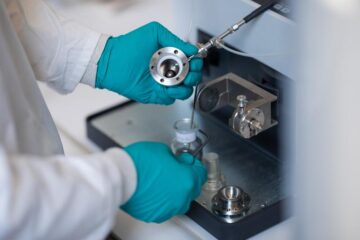Using Sonar Technologies – Researchers Learning from the Animal Kingdom

How do they do it? One of the best-kept secrets in the natural world may be about to be revealed.
Bats, porpoises and dolphins have biological sonar technology that is vastly superior to anything that man has yet devised. They use sonar to distinguish resolution and identify objects and their material characteristics for objects that are, to all extents and purposes, bewilderingly similar.
Now, researchers in the University of Leicester Department of Geology are playing a major role in a consortium of UK universities led by the British Geological Survey, in a £3.4M project to develop sonar systems based on those in the animal kingdom.
Researchers recording echolocation calls from bats in free flight hope that such technologies will have far-reaching effects in medical and geological imaging, focussing on materials characterisation and non-destructive evaluation. This will particularly apply to the search for oil, gas and other natural resources in rock samples, and may have a role in the waste management industry. The research will also enable geologists to better understand porous qualities including fracture networks in rock formations.
The four-year research project has received £3.4M funding from the Engineering and Physical Sciences Research Council (EPSRC) to apply acoustic capabilities that occur in the natural world to engineering concepts, such as biomedicine and underwater sonar.
This is not the first time that scientists have looked to the animal kingdom’s superior sense of radar, but until now they have had little success.
It is hoped that this time, with adequate funding and the collaboration of experts in bio-acoustics, geological imaging, mathematical and signal processing theory, acoustical transducer design and the implementation of experimental ’proof of concept’ engineering systems will enable scientists to solve the mystery of high-resolution acoustic imaging and the physical characterisation of objects by sonar means.
Mike Lovell, Professor of Petrophysics at the University of Leicester commented:
“This major award from the EPSRC enables us to bring together a very experienced yet diverse range of scientists into one consortium.
“As part of this truly inter-disciplinary team I am excited at the prospect of working together to advance our understanding and ability to harness the acoustic capabilities of biological systems, and to apply these to a range of practical engineering disciplines.
“At Leicester we will initially focus on the application to geological imaging, but the nature of the proposed research has broad applications beyond both geological and medical imaging.”
In addition to the BGS, partner universities are Leeds, Strathclyde, Southampton, Edinburgh, and FORTKEY Ltd while (SME) collaborators/subcontractors include Alba Ultrasound and Blacknor Technologies Ltd.
Media Contact
More Information:
http://www.le.ac.ukAll latest news from the category: Interdisciplinary Research
News and developments from the field of interdisciplinary research.
Among other topics, you can find stimulating reports and articles related to microsystems, emotions research, futures research and stratospheric research.
Newest articles

Security vulnerability in browser interface
… allows computer access via graphics card. Researchers at Graz University of Technology were successful with three different side-channel attacks on graphics cards via the WebGPU browser interface. The attacks…

A closer look at mechanochemistry
Ferdi Schüth and his team at the Max Planck Institut für Kohlenforschung in Mülheim/Germany have been studying the phenomena of mechanochemistry for several years. But what actually happens at the…

Severe Vulnerabilities Discovered in Software to Protect Internet Routing
A research team from the National Research Center for Applied Cybersecurity ATHENE led by Prof. Dr. Haya Schulmann has uncovered 18 vulnerabilities in crucial software components of Resource Public Key…





















